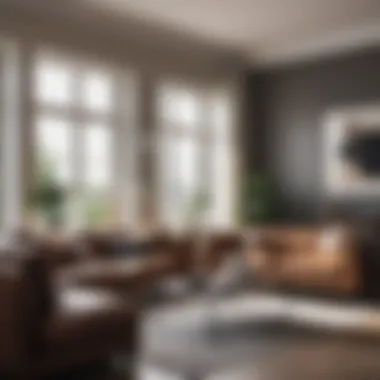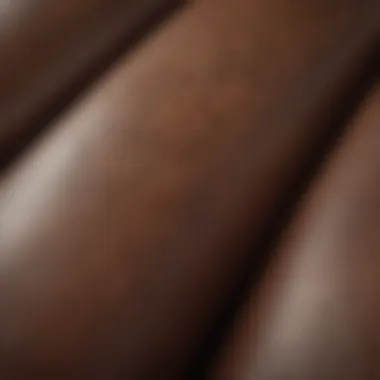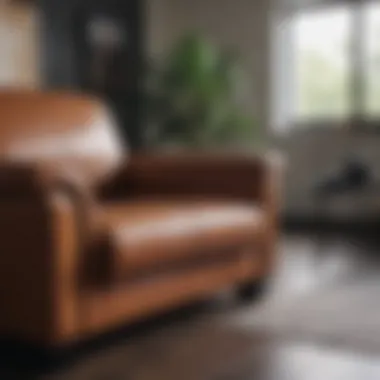Faux Leather Sofa Replacement Covers: A Comprehensive Guide


Intro
When it comes to home furnishing, few pieces play as significant a role as the sofa. For many, it serves as a central gathering point, a refuge for relaxation, and an integral part of interior style. However, the wear and tear over time can be a sore spot for just about anyone. This is where faux leather sofa replacement covers step in—the unsung heroes for modern seating arrangements.
These covers not only breathe new life into tired sofas but also bring a whole new aesthetic into the room. With their unique blend of style, practicality, and affordability, faux leather covers have gained traction among homeowners, renters, and interior designers alike. They offer a delightful assortment of textures and colors that can elevate any living space with just a simple switch.
In this examination, we will delve into the material properties, benefits, maintenance tips, and selection criteria for these transformative covers. We'll also explore current furniture trends that highlight popular styles and designs, as well as DIY projects that not only save money but also allow a personal touch.
As we embark on this journey, it’s important to understand that faux leather is not just a budget-friendly alternative for traditional leather; it’s a choice driven by aesthetics, environmental factors, and functionality. A careful consideration of these elements will help guide your ultimate decision, ensuring that your home reflects your sense of style while remaining practical and sustainable.
So, whether you're looking to spruce up an old couch, match a new decor theme, or simply explore alternative options, this guide is tailored for you.
Understanding Faux Leather
Faux leather has become a household staple, especially when it comes to furnishings like sofas. Understanding this material is crucial if you’re considering replacement covers. Faux leather, at its core, is synthetic; it mimics the look and feel of genuine leather without the ethical and financial burdens associated with animal hide. Adopted widely across various design styles, this material combines aesthetics with practicality. Homeowners and renters alike appreciate faux leather for its affordability, versatility, and ease of care.
In this section, we will dive into the definition, composition, and different types of faux leather. By examining these elements, you’ll build a solid foundation that will assist in your decision-making as you explore replacement cover options.
Definition and Composition
Faux leather refers to synthetic materials crafted to imitate genuine leather. Unlike the real deal, faux leather is designed to be more accessible and often easier to maintain, which is a significant selling point for many consumers. The composition of faux leather may vary, but it commonly consists of a textile base coated with a polymer such as polyurethane or polyvinyl chloride. This combination allows the material to possess a similar grain and texture to real leather while maintaining durability and flexibility.
Furthermore, faux leather can come in various finishes and colors, making it adaptable for multiple decor styles, from modern minimalist to rustic chic. Its makeup enables a level of creativity that real leather would not easily support.
Differences Between Faux and Real Leather
The distinctions between faux and real leather are not merely superficial; they extend far beyond appearance. Firstly, real leather, derived from animal hides, carries a certain level of prestige and durability, but it often comes with a hefty price tag. On the other hand, faux leather provides a budget-friendly alternative that doesn’t skimp on style.
However, faux leather is not without its drawbacks. Over time, it may wear down more quickly than genuine leather, experiencing peeling or cracking. In terms of environmental impact, while faux leather avoids the animal cruelty associated with real leather, the production processes can still contribute to ecological damage, depending on the materials used. This dichotomy places consumers in a thoughtful position when navigating their choices.
Types of Faux Leather
Exploring the various types of faux leather gives insight into its versatility. Among the most prevalent are:
- Polyurethane: This material is popular because it closely mimics the texture and appearance of real leather. Polyurethane is flexible, durable, and can be made to look soft and luxurious. It's commonly used in high-quality furniture and car upholstery. However, it can be sensitive to heat and may require careful storage to avoid premature wear.
- Polyvinyl Chloride (PVC): Known for its sturdiness, PVC is often more resistant to wear and tear compared to polyurethane. It’s a budget-friendly option and operates well for public spaces where durability is essential. On the flip side, PVC may not be as breathable, leading to a potentially less comfortable seating experience long-term.
- Microfiber: This is a softer fabric composed of polyester and nylon fibers, which gives it a velvety feel. Microfiber faux leather is often praised for its stain resistance and easy maintenance. It offers a plush reading nook on a cold winter evening but can be prone to showing dirt more readily than other faux leathers, thereby requiring frequent cleaning.
The Advantages of Faux Leather Sofa Replacement Covers
Faux leather sofa replacement covers have gained considerable traction in the home furnishing market. Their appeal lies in the myriad of benefits they bring to homeowners, renters, and designers alike. These covers are not merely a protective sheath for your sofa; they are smart investments that can enhance aesthetics, prolong the life of your furniture, and offer a degree of versatility difficult to find in traditional upholstery. Understanding these advantages allows individuals to make more informed decisions when choosing replacement covers for their sofas.
Affordability and Accessibility
One of the standout features of faux leather sofa replacement covers is affordability. Unlike genuine leather, which can require a king's ransom, faux alternatives provide a budget-friendly solution without sacrificing style. Homeowners looking to refresh their living spaces don't need to dig deep into their pockets; they can achieve a high-end look on a shoestring budget. This accessibility is critical for renters who often face the challenge of fitting their style into a temporary living situation. With faux leather covers, you can easily switch up your home decor without committing to a long-term investment.
In a world where style and functionality sometimes clash, faux leather offers a practical middle ground. Think of this: outfitting your space with a high-quality faux leather cover can elevate the entire look of your room, impressing guests without loading up on unnecessary expenses.
Variety of Styles and Designs
Variety is the spice of life, and faux leather covers certainly don't disappoint in this regard. From vibrant colors to classic neutrals, these covers come in a plethora of designs that can suit every taste and interior theme. Whether you are going for a modern minimalist look or a more eclectic, bohemian vibe, faux leather offers a range of textures and patterns that can seamlessly integrate into various spaces.
It's important to consider how different faux leather options can impact your overall decor. For example, a rich burgundy cover can create an inviting warmth, while a sleek black finish can lend a contemporary, edgy feel to a room. Additionally, with trends constantly evolving, faux leather provides a versatile salon to experiment with seasonal changes in aesthetics without the worry of replacing an entire sofa.
Ease of Maintenance
When it comes to maintenance, faux leather sofa covers win hands down. Unlike their real leather counterparts, which can be finicky and require specialized cleaners, faux leather is relatively straightforward to care for. Spills wipe away easily, and typical dirt or grime can often be managed with just a damp cloth and mild soap. This ease of upkeep makes faux leather an ideal choice, especially in households with pets or young children.


Moreover, regular cleaning not only preserves the cover's appearance but also prevents any build-up that could lead to lasting damage. Thus, investing in faux leather covers is much more practical for those with busy lifestyles. It's one less thing to stress over, making it suitable for the fast-paced environment we often find ourselves in today.
Ethical Considerations
In an increasingly eco-conscious world, ethical aspects of our purchases are becoming critical. Faux leather replacement covers pave the way for conscious consumerism, as they don’t necessitate the use of animal hides. This makes them more appealing to individuals who are ethically inclined and prefer avoiding the environmental impact associated with real leather production.
However, the conversation doesn't stop there. It's essential to consider the nature of materials used in faux leather. While they are an alternative to animal products, certain types may still pose environmental concerns, particularly regarding sustainability and recyclability. Therefore, opting for high-quality covers that use more eco-friendly materials can provide peace of mind on both style and ethics.
"When choosing faux leather, consider not just aesthetics but also the eco-impact of the materials used."
Selecting the Right Faux Leather Covers
Choosing the right faux leather covers is not like picking a candy from the jar. It requires serious consideration. Faux leather sofa replacement covers are readily available, yet not all covers are created equal. Picking the appropriate covers can enhance not only the appearance of your sofa but also ensure that it lasts for years to come.
When diving into the world of faux leather, it’s crucial to keep in mind the quality of the material, the correct size to fit your couch, and the color or texture that harmonizes not only with your couch but also with the whole room's aesthetics. A well-chosen cover doesn’t just protect your furniture; it elevates the entire space. Here's a closer look at the crucial factors to consider.
Evaluating Material Quality
When considering replacement covers, material quality should be at the forefront. A top-notch faux leather cover should feel sturdy and have a notable thickness. Think of it as a handshake: a weak grip demonstrates vulnerability. Two common types used are polyurethane (PU) and polyvinyl chloride (PVC). PU tends to be softer and more flexible, which can be a good option for those who prefer comfort. In contrast, PVC is more durable and resistant to wear and tear, making it appealing for busy households.
Keep an eye out for other telltale signs of quality. Features such as stitching and overall craftsmanship can hint at longevity. Avoid covers that have loose threads or uneven seams. Often, the more you invest upfront, the less you will have to fret about repeated replacements.
Understanding Size and Fit
Getting the size right is fundamental – it's akin to trying to cram into shoes that don't match. Faux leather covers come in various sizes, so it’s essential to measure your sofa accurately before making a purchase. You want to ensure that it hugs the contours of your couch rather than looking baggy or stretched out.
Here’s a quick checklist to consider:
- Measure your sofa's dimensions: Width, depth, and height all matter. Don’t forget to consider armrests if present.
- Check the manufacturer's specifications: Some brands provide sizes that might be slightly different.
- Take note of the style: Recliners or sectionals may have unique sizing needs.
When in doubt, reaching out to customer service can make a world of difference. They can help provide guidance on size compatibility.
Choosing the Appropriate Color and Texture
Lastly, the color and texture of the cover tie everything together. It can dramatically change the vibe of your room. Faux leather offers an impressive array of shades and finishes, from matte to glossy.
- Neutral colors: Shades of beige, gray, or black are versatile and timeless. They can blend seamlessly into almost any decor.
- Bold colors: If you're looking to make a statement, don't shy away from vibrant hues. Just remember, when you choose a striking color, think about how it complements the rest of your space.
- Texture matters: Some faux leathers have a grainy finish, while others are smooth. Consider the overall design of your home. A rustic space might benefit from textured finishes, whereas a modern home could suit smoother options.
Ultimately, selecting the right faux leather cover combines personal taste with practical application. The right choice enhances your living area while protecting your furniture.
In the quest for the perfect faux leather sofa cover, blend quality with aesthetics and ensure a snug fit. This careful selection process promises a space you’ll love for years to come.
Practical Installation Tips
When it comes to faux leather sofa replacement covers, practical installation tips play a crucial role in ensuring a smooth transition from old to new. These guidelines not only help in achieving a flawless look but also enhance the durability of the covers. A well-installed cover can transform the appearance of your sofa, giving it a fresh lease on life while protecting it from everyday wear and tear.
Preparing the Sofa
Before diving into the installation process, it's vital to prepare your sofa for the new cover. This step is akin to laying a solid foundation before building a house. Here are essential points to consider:
- Clearing the Area: Make sure to remove any items from the sofa. Cushions, throws, or decorative elements can get in the way and cause distractions during the installation.
- Cleaning the Sofa: Dust, dirt, or any debris on the sofa can affect how the cover fits. Wipe down the surface with a damp cloth. If necessary, use a mild detergent, but ensure the sofa is completely dry before proceeding.
- Inspecting for Damage: Check for any damages, like loose stitches or broken springs. Fixing these issues beforehand can prevent complications during installation and prolong the life of your new cover.
Step-by-Step Installation Guide
Installing faux leather sofa covers doesn’t have to be a daunting task; breaking it down into steps can make this easier. Here’s a simple guide:


- Lay Out the Cover: Start by taking the cover out and laying it flat on a clean surface. Familiarize yourself with its design and identify where each part goes. This is about getting acquainted with the cover like an old friend.
- Start with the Back: Position the cover over the back of the sofa first. Tuck it in gently, ensuring it sits snugly without any bunching. A tight fit here can set a solid tone for the rest of the installation.
- Work from Top to Bottom: Gradually move down to the sides and then the front. Be sure to pull the cover with equal tension on both sides to avoid any lopsided appearance.
- Adjusting Fit: Once the cover is on, adjust any areas that don’t seem quite right. Take your time—this is the moment to perfect it.
- Securing the Cover: If your cover comes with ties, Velcro, or elastic bands, make sure to use them to secure the cover in place. This will help in maintaining the coverage, especially in high-use areas.
Common Installation Mistakes to Avoid
Even the most seasoned DIYers can find themselves making the same blunders. Here’s a run-down of common pitfalls to steer clear of:
- Ignoring the Manufacturer’s Instructions: Skimming through or overlooking the provided instructions can lead to a variety of issues. It’s essential to follow the specific guidelines tailored for your cover.
- Rushing the Process: Installation is not a race. Taking your time ensures that everything fits perfectly and looks professional. Rushing can lead to wrinkles and improper alignment.
- Not Prepping the Sofa Properly: Failing to clean or inspect the sofa beforehand can result in a sloppy finish. A good prep does wonders.
- Forgetting to Get the Right Size: Ensuring the cover is the right size for your sofa is key. Using a cover that’s too big or too small leads to frustration during installation and can affect the overall look.
Remember: "A stitch in time saves nine." Taking a moment to prepare can save you hours of potential hassle.
By adhering to these practical installation tips, one can effortlessly breathe new life into a sofa while maintaining its aesthetic appeal. A successful installation not only serves functionality but also amplifies the decor in one’s living space.
Maintaining Faux Leather Sofa Replacement Covers
When it comes to faux leather sofa replacement covers, proper maintenance is crucial for ensuring they remain vibrant and functional over time. The aesthetic appeal of your furniture can significantly impact the overall atmosphere of your living space. Not to mention, these covers are designed to protect your investment under the wear and tear of daily use. A little bit of care goes a long way, extending the life of the cover and keeping it looking fresh and inviting.
Importance of Maintenance
Taking care of your faux leather covers not only helps preserve their appearance but also promotes hygiene. Faux leather can accumulate dust, spills, and odors, much like any other upholstery. Hence, regular cleaning and maintenance practices will prevent damage while enhancing comfort.
Cleaning Methods and Best Practices
To make cleaning straightforward, follow these tried-and-true methods:
- Use a Soft Cloth: A microfiber cloth is an excellent tool for cleaning faux leather. It's gentle yet effective at lifting dirt and debris without scratching the surface.
- Mild Soap Solution: Mix a few drops of mild liquid soap with warm water. Dampen the cloth with this solution and wipe the cover clean, followed by a damp wipe with plain water to remove soap residues.
- Avoid Harsh Cleaners: Steer clear of ammonia or bleach-based cleaners—these can cause irreversible damage.
"Regularly cleaning your covers not only maintains their look but also helps to eliminate allergens, creating a healthier home environment."
Dealing with Stains and Damage
Every faux leather sofa will encounter its fair share of stains, spillages, and potential scuffs. Being prepared is essential:
- Immediate Action: If a spill occurs, act swiftly. Blot it with a clean cloth rather than wiping. This prevents the liquid from spreading or soaking deeper into the material.
- Dab on the Cleanser: For tougher stains, you may use a blend of three parts water and one part vinegar. Use a cloth to carefully dab the solution onto the stain. Allow it to sit for a few minutes before blotting it dry with another soft cloth.
- Patch Test: When trying any new cleaning method or solution, always perform a patch test on an inconspicuous area first to avoid unwanted discoloration.
Long-Term Care Recommendations
Keeping faux leather in prime condition requires some long-term strategies as well:
- Avoid Direct Sunlight: Exposure to intense sunlight can lead to color fading. Whenever possible, place your sofa in a shaded area or utilize window treatments.
- Condition the Material: While faux leather doesn’t need conditioning like genuine leather, applying a specially formulated cleaner every few months can help maintain its flexibility and luster.
- Store Properly: If you ever plan to store your covers, do so in a dry place and avoid folding them tightly to prevent creases.
Regular maintenance involves a combination of preventive measures and timely care. By keeping these strategies at the forefront, you’ll not only ensure your faux leather replacement covers maintain their allure but also provide a welcoming environment for friends and family.
Balancing Aesthetics and Functionality
When it comes to home design, walking the tightrope between aesthetics and functionality can feel like a balancing act. Faux leather sofa replacement covers manage to merge these two vital aspects quite effectively. On one hand, they provide a stylish appearance that enhances the visual appeal of any living space; on the other, they offer durability and ease of use that cater to everyday living. Balancing these two elements is crucial for homeowners, renters, and designers alike.
Considerations for Aesthetic Value
Faux leather covers come in a range of colors, textures, and designs that can that make a bold statement in a room. From deep navy hues to bright mustard yellows, these covers are not just functional; they elevate the entire decor. They bring a certain je ne sais quoi to your sofa without the hefty price tag associated with real leather.
Additionally, choosing the right design can create focal points or blend seamlessly with other furnishings. Patterns or textures can complement other elements in the room. It is key to find the right aesthetic that speaks to your style—be it minimalistic, eclectic, or traditional—making your space truly unique.
Functionality at Its Best
Beyond aesthetics, the functionality of faux leather replacement covers is noteworthy. Faux leather, being fairly simple to clean, ensures that your furniture can withstand the test of time—especially if you have kids or pets at home. Just a quick wipe-down with a damp cloth can rid the fabric of spills or stains, making it very user-friendly.
Faux leather is a strong material that resists wear and tear. Unlike some other fabric options, you won’t have to worry as much about snagging or causing irreversible damage from heavy use. The durability factor brings peace of mind. At the end of the day, you want to have a beautiful room that also serves its purpose.
"A design isn't just about how something looks; it's also about how it works and fits into your life."
The Sweet Spot
Finding that sweet spot where aesthetics and functionality meet is essential. Faux leather replacement covers offer this balance. Selecting the right cover means paying attention to how it will look with your existing decor while also considering its long-term usability. Are you ready to give your sofa a makeover that speaks style while also standing the test of time? Navigating this territory can initially seem daunting, but once you pinpoint your needs and preferences, the choices become clearer.


Designing with Faux Leather
Creating inviting spaces with faux leather starts with recognizing its versatility. Not just for sofas, faux leather can be integrated into various design elements around the home. Throw pillows, ottomans, and even wall accents can pull together your design theme beautifully.
Choosing the right faux leather requires understanding which quality suits your needs. Whether you prefer the smooth finish of polyurethane or the matte touch of microfiber, the choice will make a significant impact on the feel of your space. Keep your overall design in mind.
Creating Cohesive Space Designs
Achieving cohesiveness is about more than combining various elements; it's about creating a seamless experience. Faux leather provides the flexibility needed to tie different parts of a room together. Use the same faux leather patterns or complementary colors across various pieces to create a harmonious design.
For instance, if your sofa cover is a rich chocolate brown, consider using similar tones in your choice of cushions or drapes. This kind of coordination can transform a disjointed arrangement into a well-thought-out visual experience.
Establishing a consistent theme will enhance the aesthetic value of your space while retaining the needed functionality. In the end, a well-balanced design using faux leather can reflect personal style while serving practical everyday needs.
Environmental Impact of Faux Leather
When one thinks about home furniture, the ecological effects might not spring to mind immediately. However, the truth is, the choice of materials in sofa replacement covers has a profound impact on our planet. Faux leather, often seen as a modern and ethical alternative to genuine leather, carries its own set of environmental implications worth discussing. This section aims to shed light on these impacts, including the sustainability of the materials used and the challenges that come with biodegradability.
Sustainability of Materials Used
The production of faux leather often utilizes synthetic polymers, predominantly polyurethane or polyvinyl chloride. While these materials allow for a range of appealing styles and finishes, their production isn't without detriment. On one hand, faux leather can reduce the demand for animal hides, which may seem like a win for animal welfare. But on the flip side, the manufacturing processes can contribute to pollution and resource depletion.
Key points to consider regarding the sustainability of faux leather include:
- Resource Extraction: The petrochemicals used in faux leather are derived from non-renewable resources. The extraction of fossil fuels, a primary component, has environmental consequences, including habitat destruction and carbon emissions.
- Production Emissions: Creating synthetic leather comes with a carbon footprint, as energy-intensive processes release greenhouse gases. It's crucial for manufacturers to adopt cleaner production methods to lessen this impact.
- Longevity vs. Replacement: High-quality faux leather can last quite a while, but lower-quality versions may degrade faster, leading homeowners to replace them more frequently. This leads to increased waste and raises questions about sustainability over time.
Biodegradability Challenges
One of the most significant challenges with faux leather lies in its biodegradability. Unlike natural materials, synthetic leather does not break down easily in landfills.
- Landfill Concerns: Once discarded, faux leather can persist for many years, as it's often made from plastics that don’t easily decompose. This can lead to accumulating waste and environmental pollution.
- Incineration Issues: While some might think burning faux leather could be a solution, the reality is that combustion can release harmful chemicals and toxins into the air, exacerbating pollution and health issues in surrounding communities.
- Innovative Solutions: Some brands are pioneering efforts in creating more sustainable faux leathers through the use of bio-based materials or recyclables. However, these products are still not widely available, and their effectiveness may vary.
The significance of evaluating faux leather's environmental impact cannot be overlooked. Replacing a sofa cover might seem like a small decision, but it adds to a larger narrative around sustainability and conscious consumption.
In summation, while faux leather provides various benefits and options for homeowners and designers, the environmental implications demand careful consideration. By understanding the sustainability of the materials and the biodegradability challenges, consumers can better navigate their choices toward a more eco-friendly future.
Ending: Making Informed Choices
In the world of interior design, faux leather sofa replacement covers stand out as not just a decorative element but as a versatile choice that influences the overall ambiance of a space. The conclusion of this exploration underscores the importance of making informed decisions when selecting these covers. Understanding the unique properties of faux leather, as well as the implications for aesthetics, functionality, and environmental impact, fosters a more mindful approach to home furnishing.
The process of choosing the right cover isn't merely about aesthetics; it demands a keen eye for quality, durability, and ethical considerations. There are direct implications on how well the cover will perform over time and how it will complement existing decor. As one delves deeper, one finds that the satisfaction derived from these choices often leads to an enhanced living experience.
Recap of Key Considerations
- Material Quality: Prioritize high-quality materials. Faux leather can vary greatly in terms of durability and feel.
- Fit and Size: Select covers that properly fit your specific sofa model. A properly fitted cover enhances the aesthetic value and longevity.
- Style and Color: Consider the overall palette of your living space when choosing colors and textures – harmony is key.
- Maintenance: Reflect on the ease of cleaning and upkeep that various types of faux leather demand.
- Environmental Factors: Keep in mind the sustainability aspects and the environmental impact of the materials used.
Taking all these into account will allow homeowners, renters, and designers to make choices that not only suit their immediate needs but also align with their long-term goals.
Empowering Consumer Decisions
Empowerment comes from knowledge, and the informed consumer is a force to reckon with. Understanding the intricacies of faux leather fabrics and their implications for styling one's living area enables consumers to make choices that reflect their taste while being socially conscious.
A few key actions can facilitate this:
- Research: Seek out different materials and suppliers. Found resources can provide insights into the best faux leather options available.
- Seek Transparency: Engage with brands that are open about their sourcing and production practices. This transparency can guide more ethical purchasing decisions.
- Evaluate Feedback: Look for reviews and testimonials from previous customers. Often, ratings can shed light on the durability and look of faux leather over time.
By adopting these practices, consumers can navigate the wide array of faux leather options available. Making choices informed by knowledge not only enhances one's living space but also aligns with broader ethical and sustainability goals.
Informed choices create spaces that resonate with personal values and long-term satisfaction.
In all, embracing the detailed considerations around faux leather sofa replacement covers is an essential part of curating a harmonious and functional living space.















